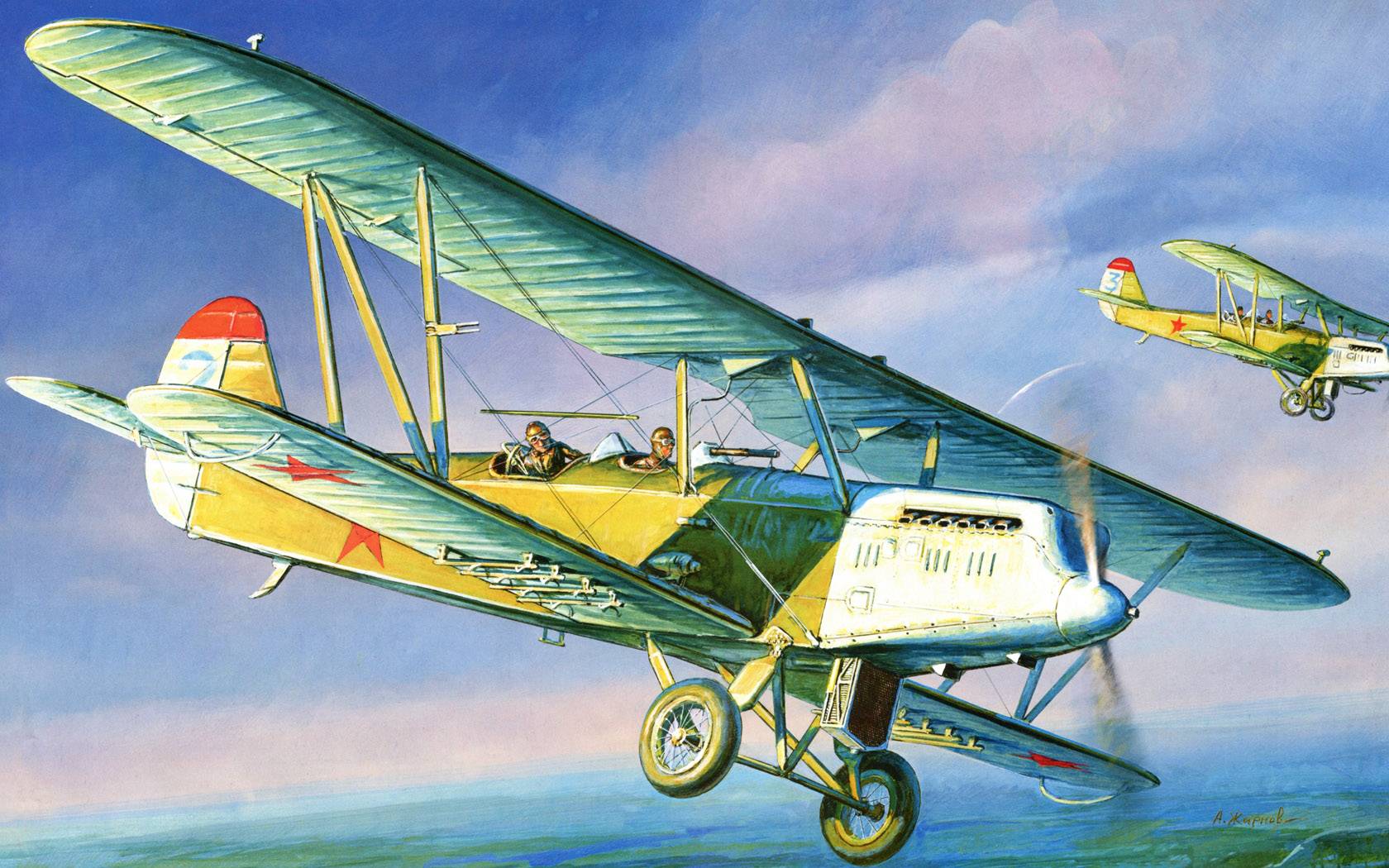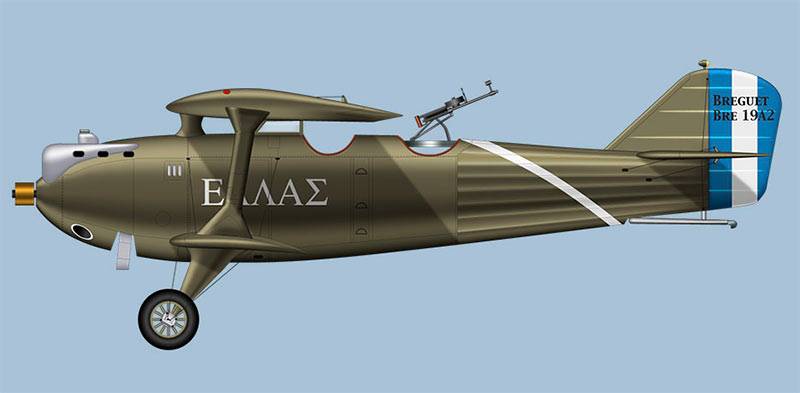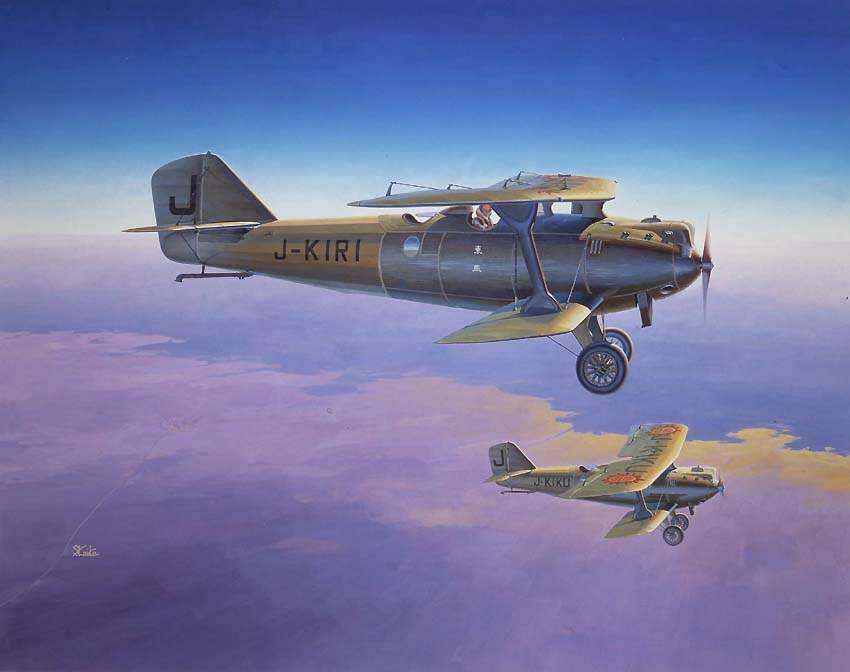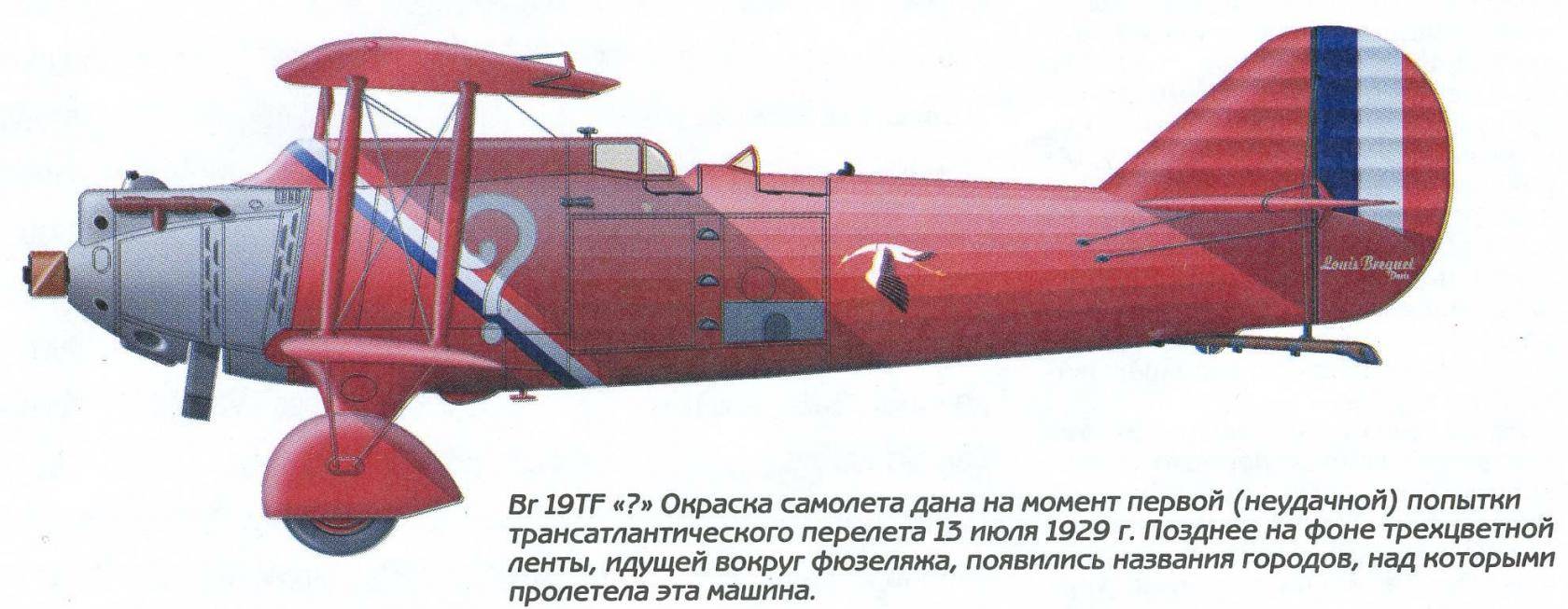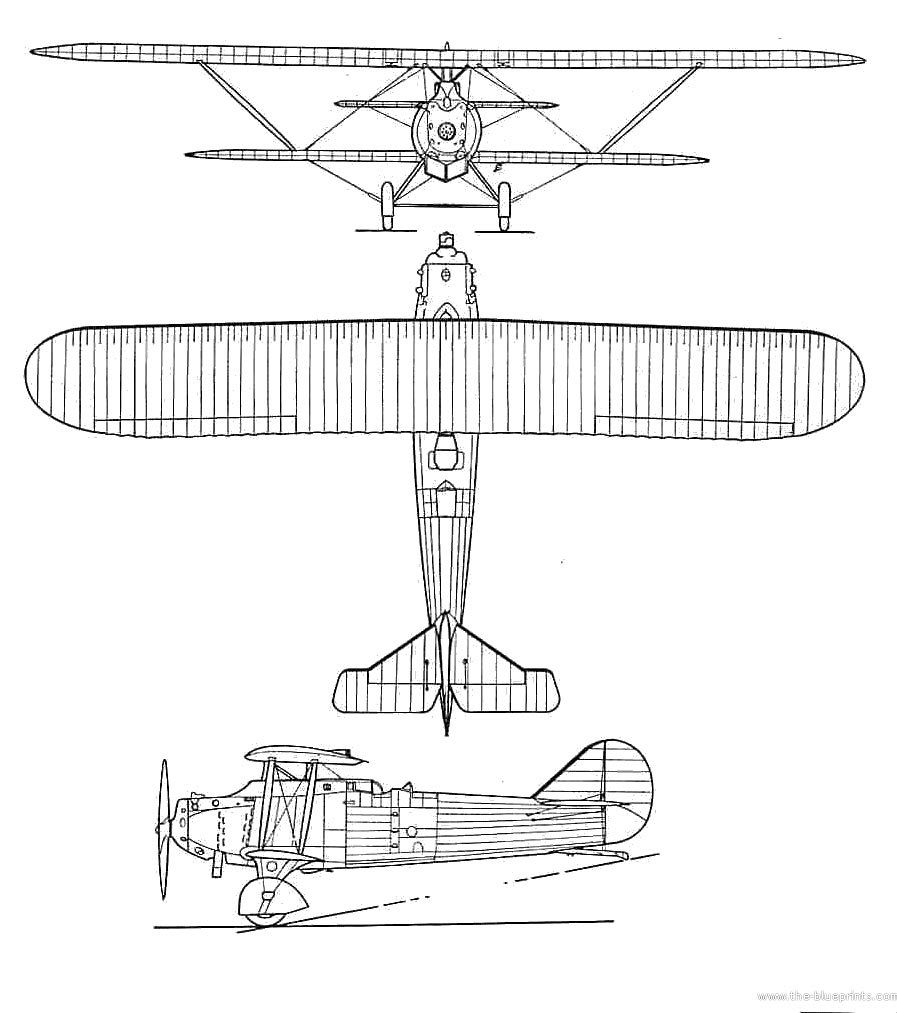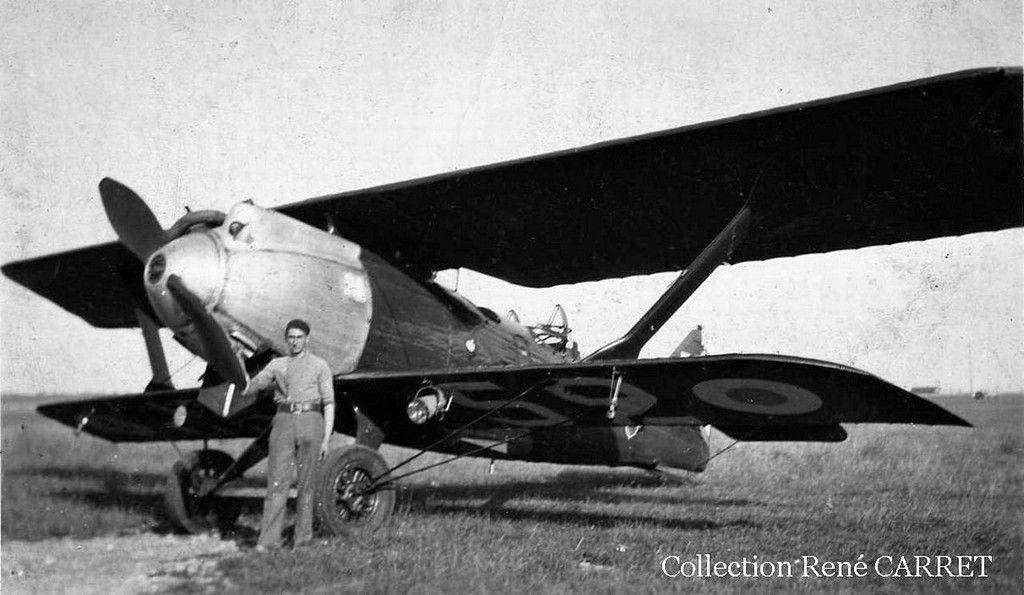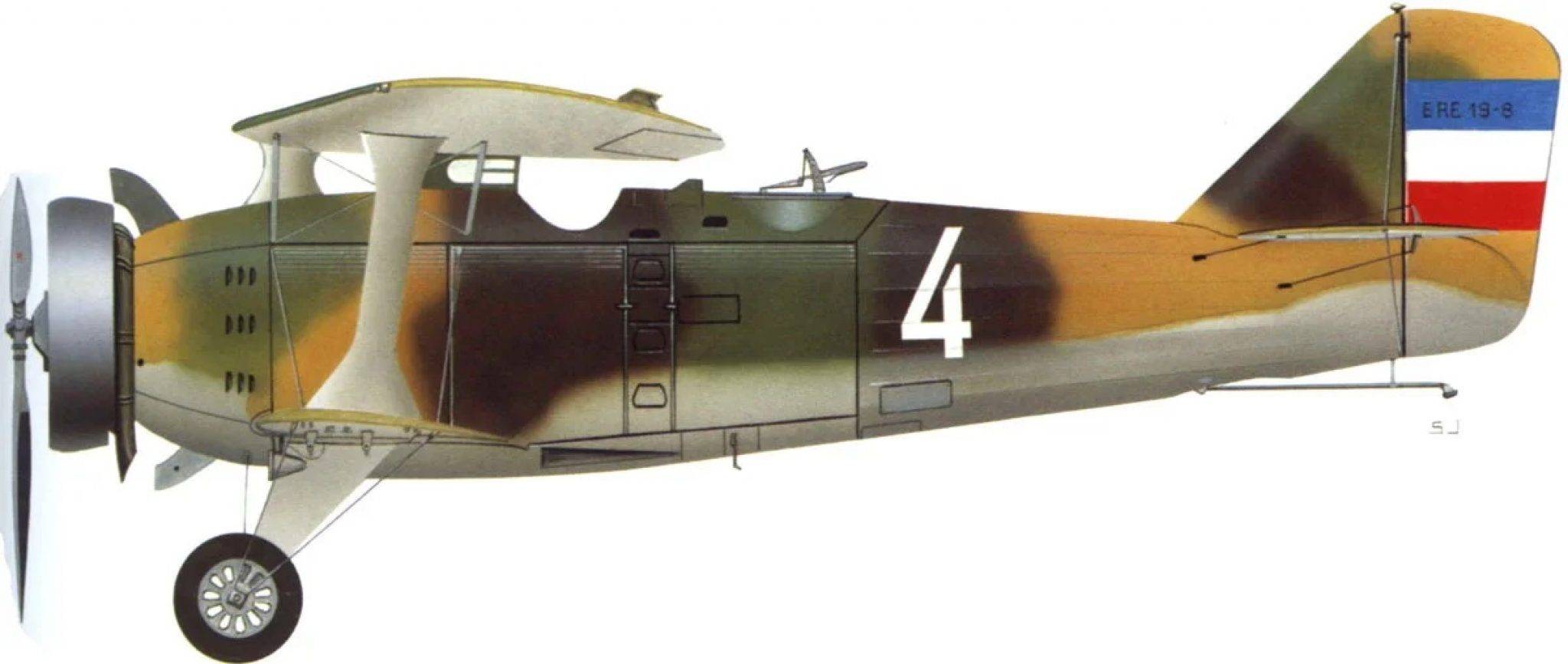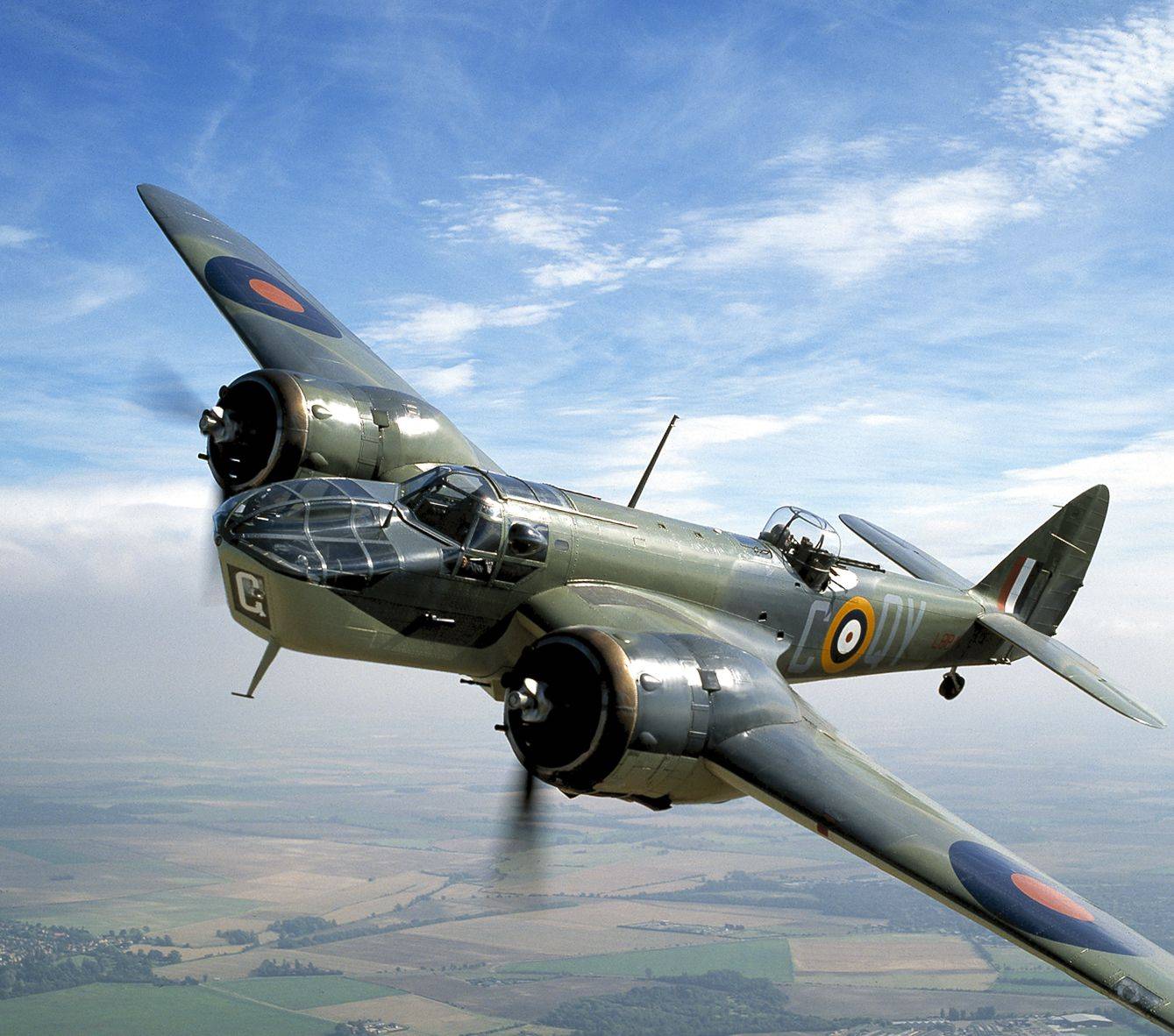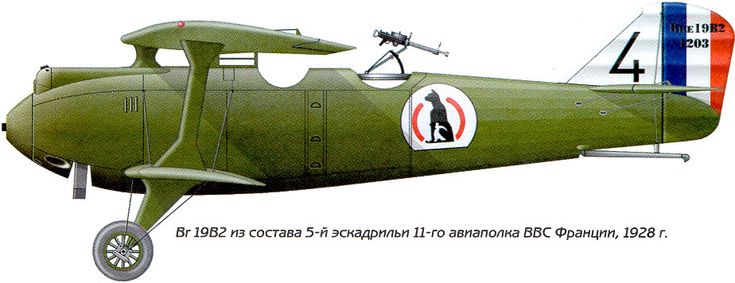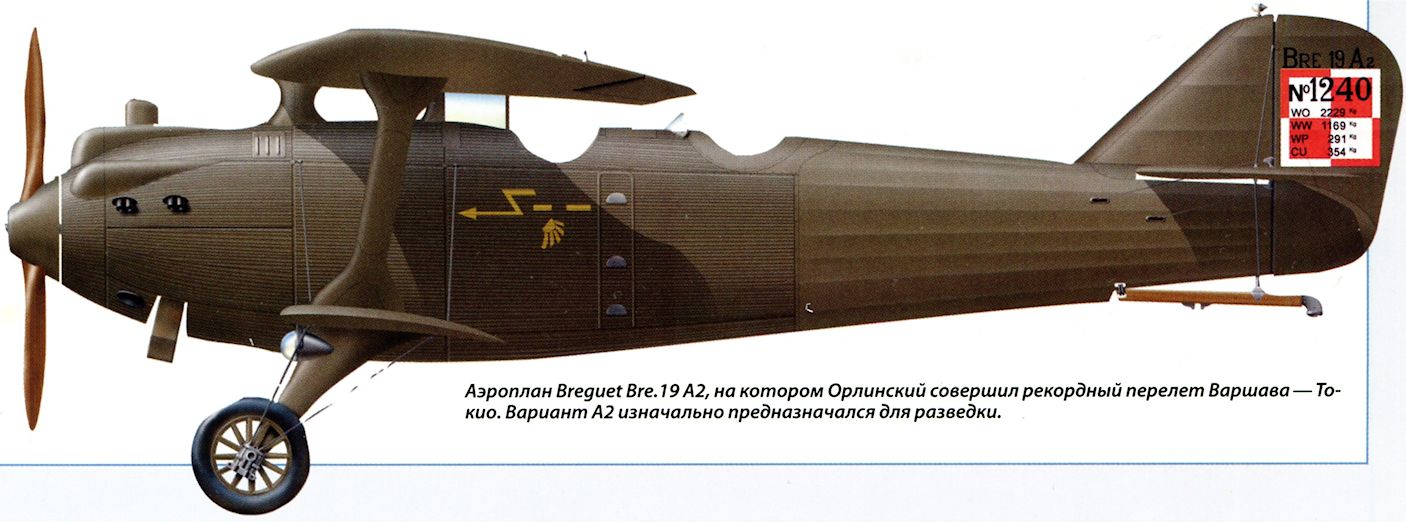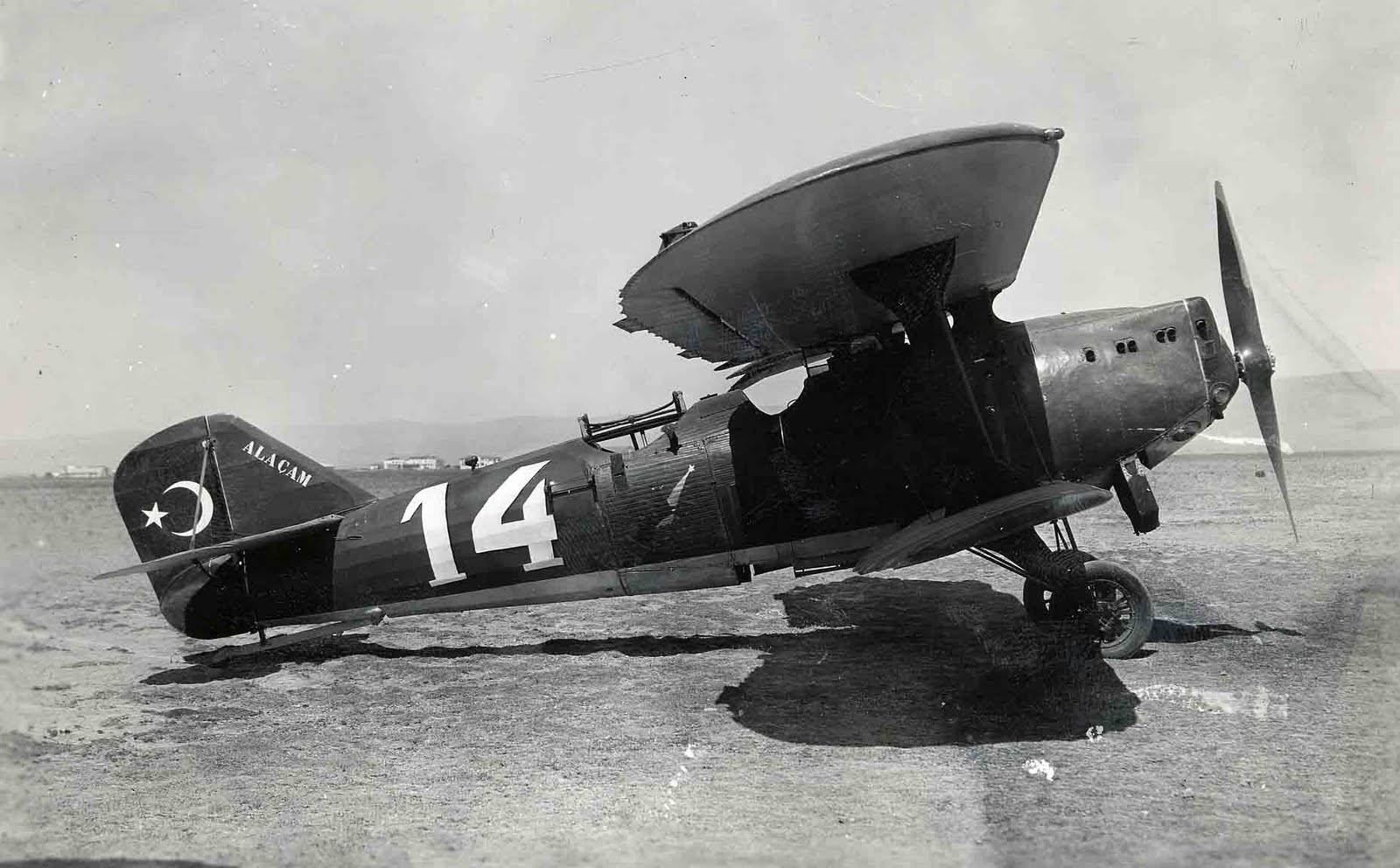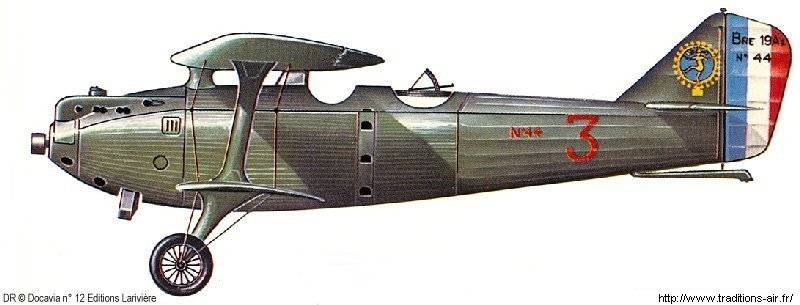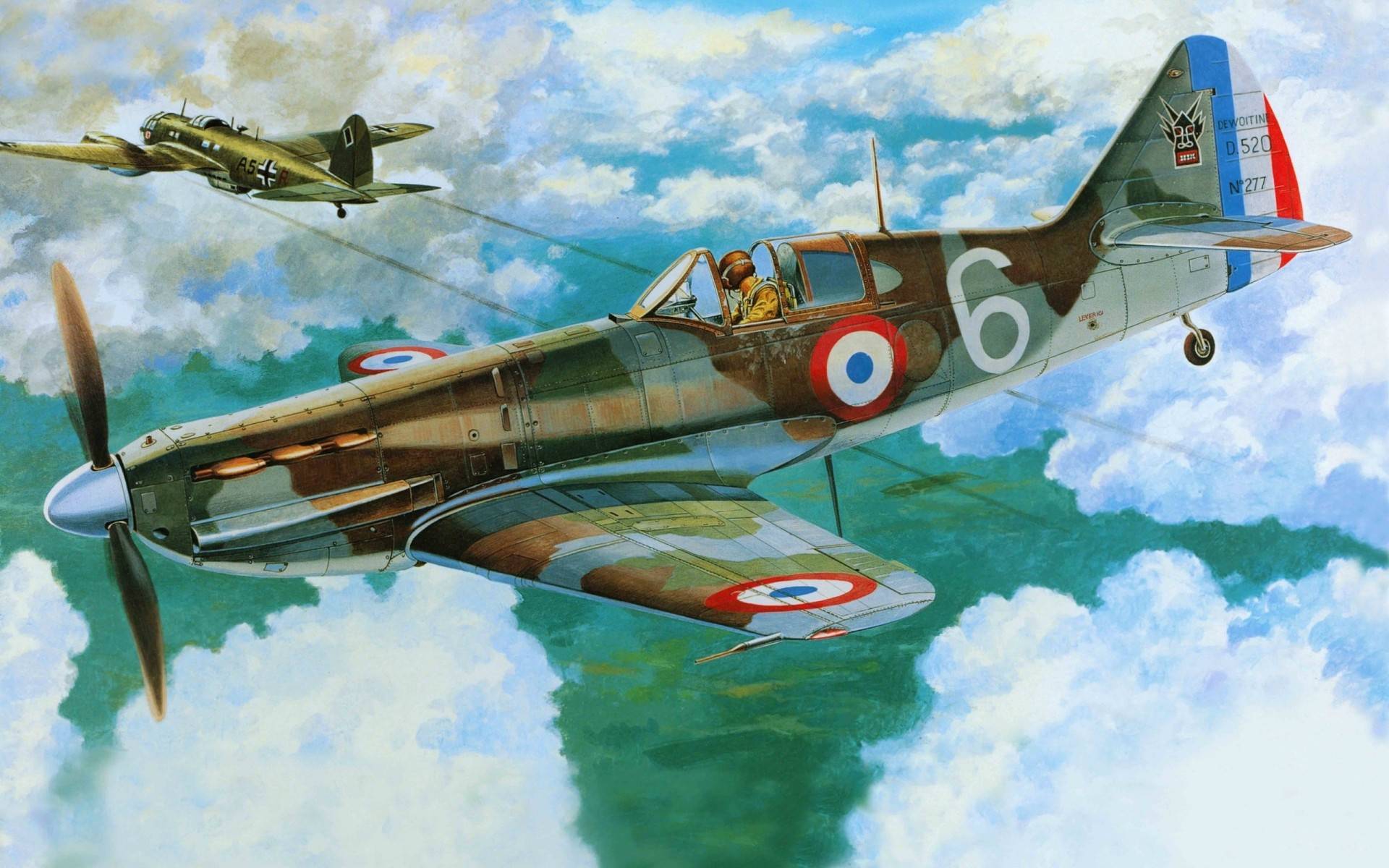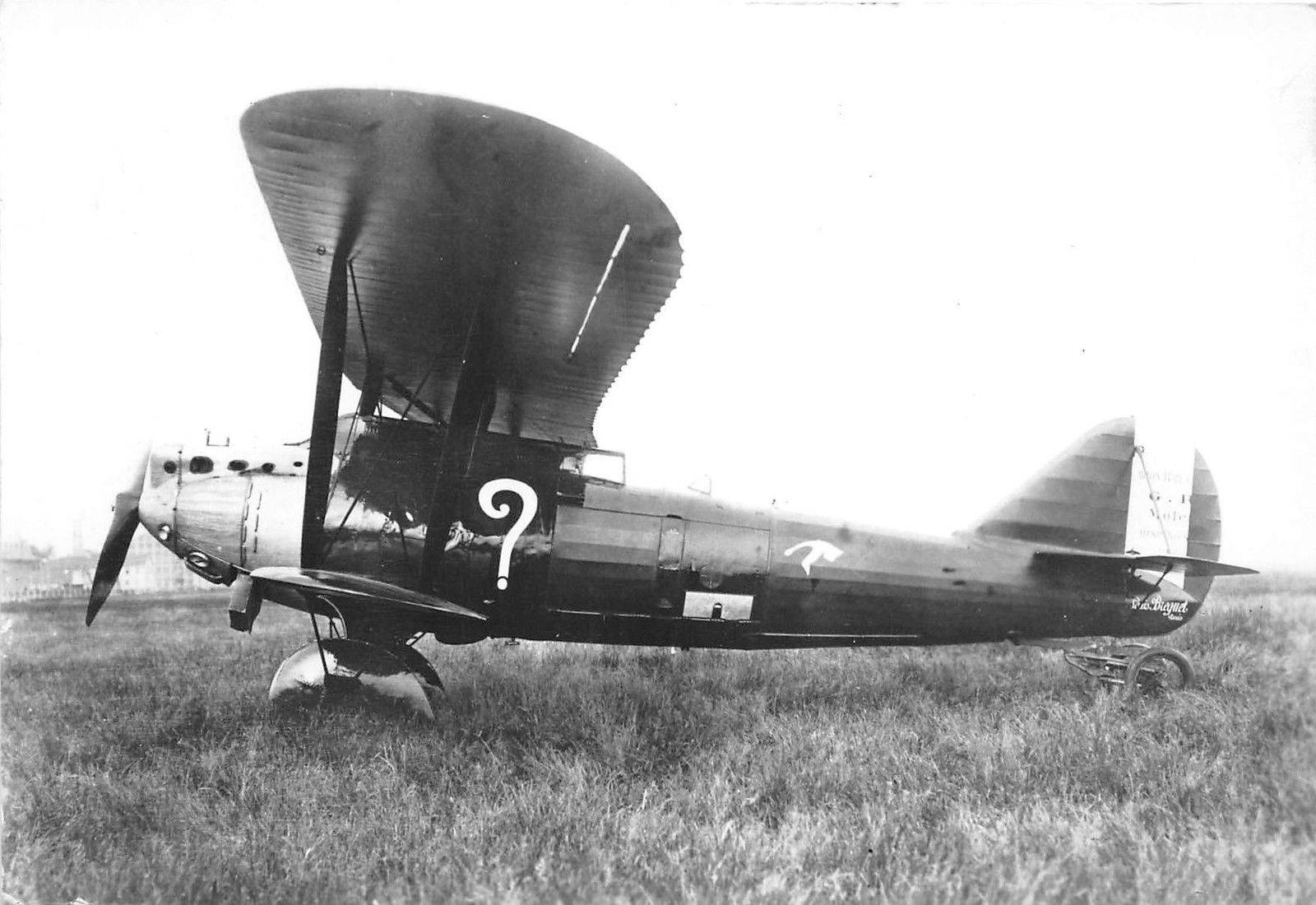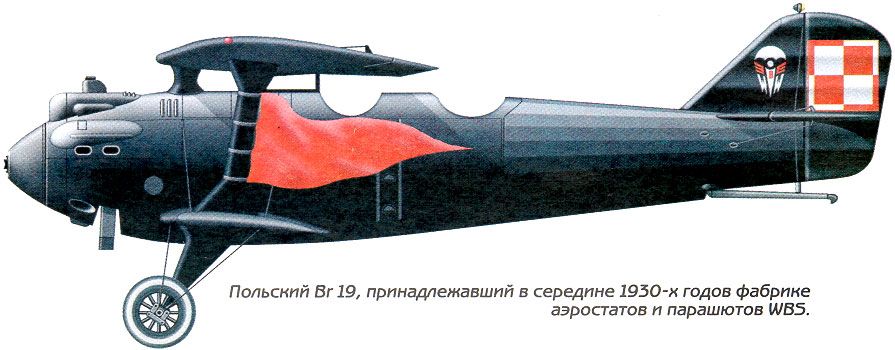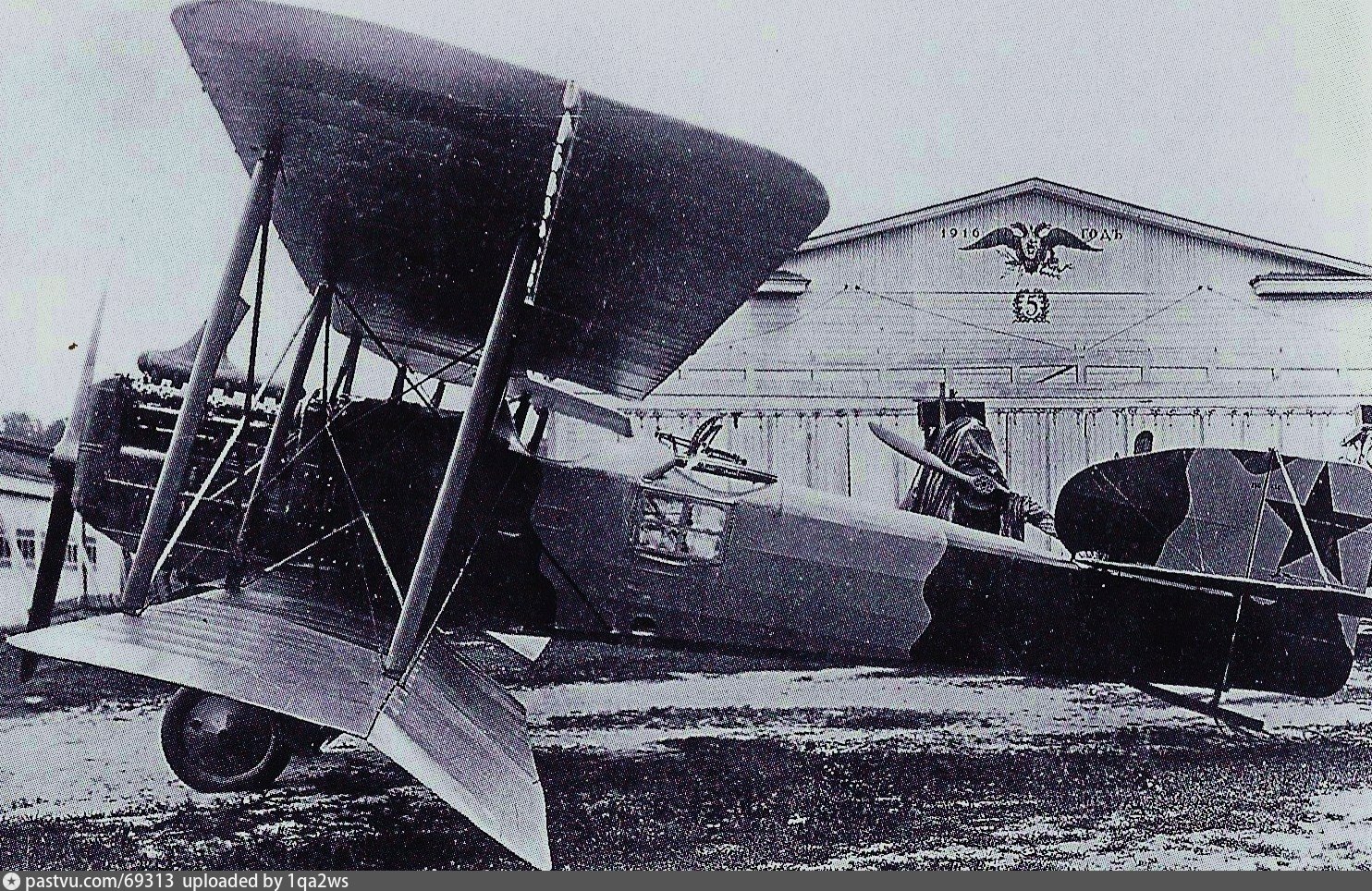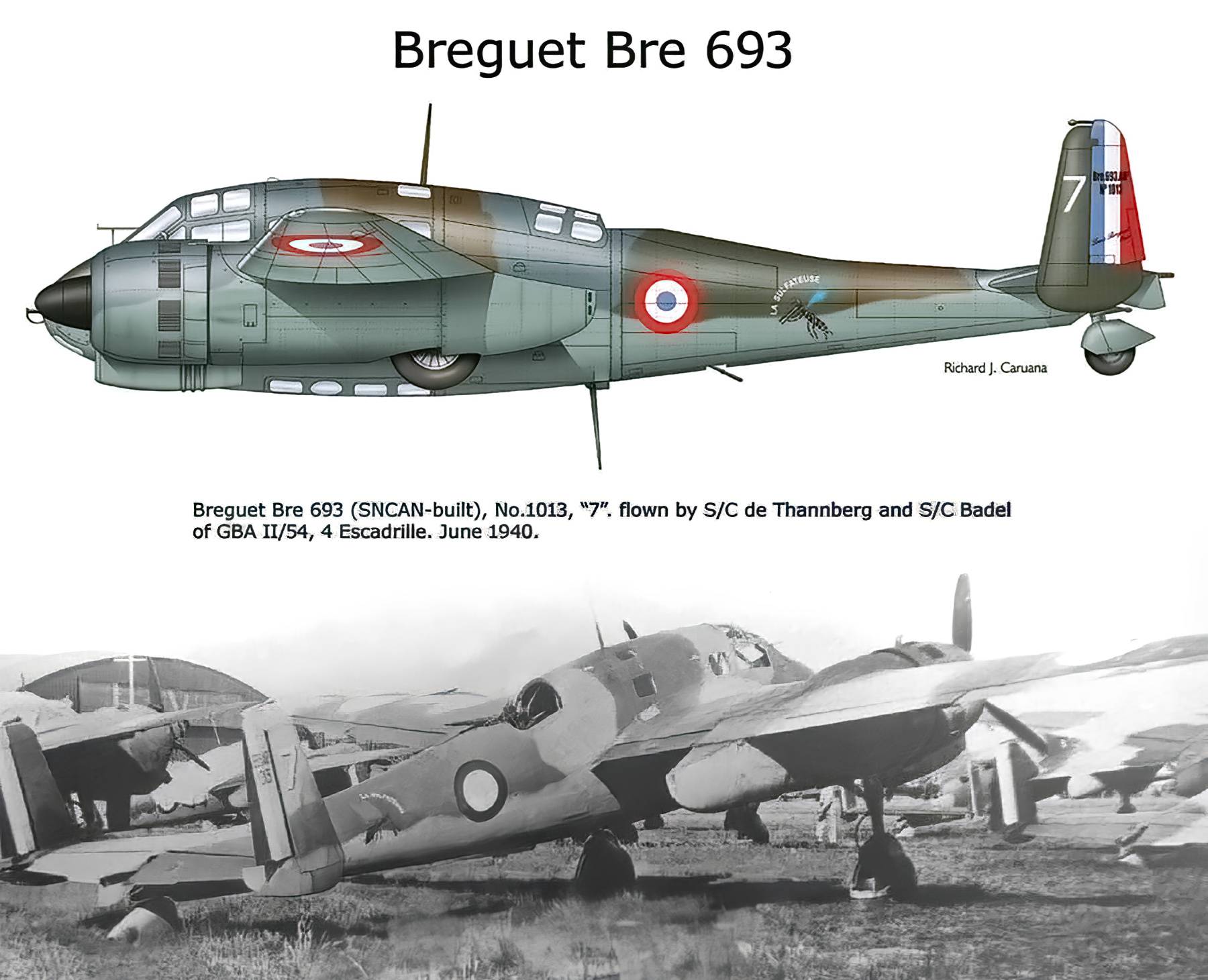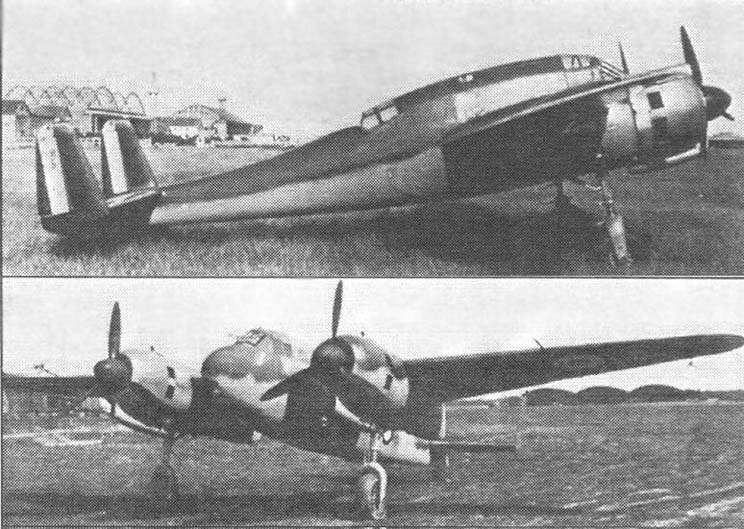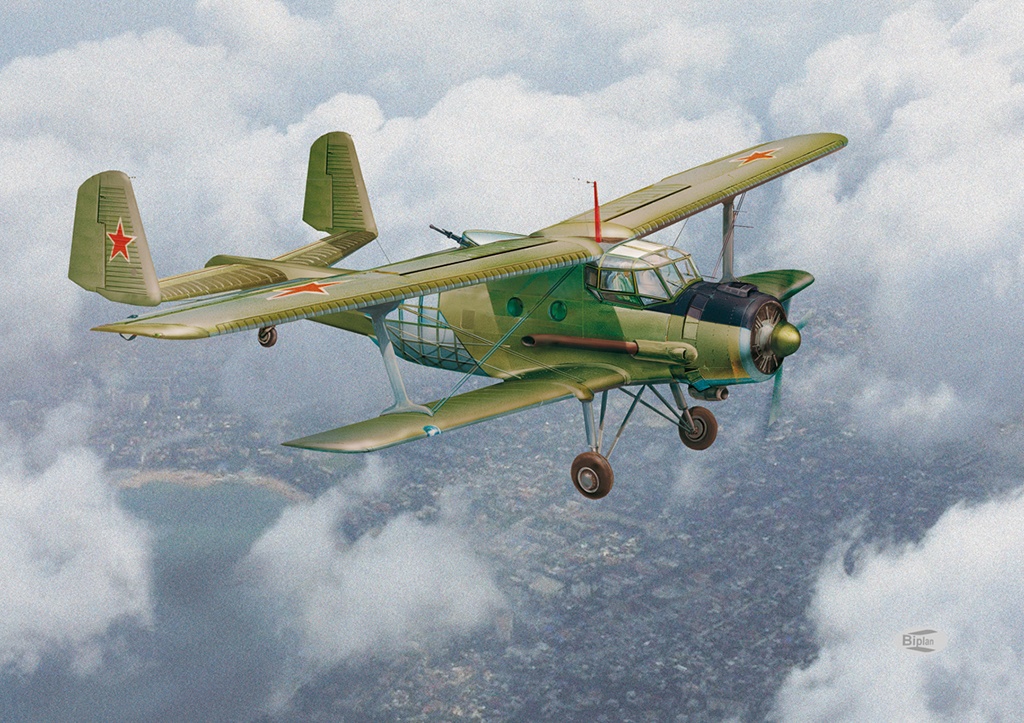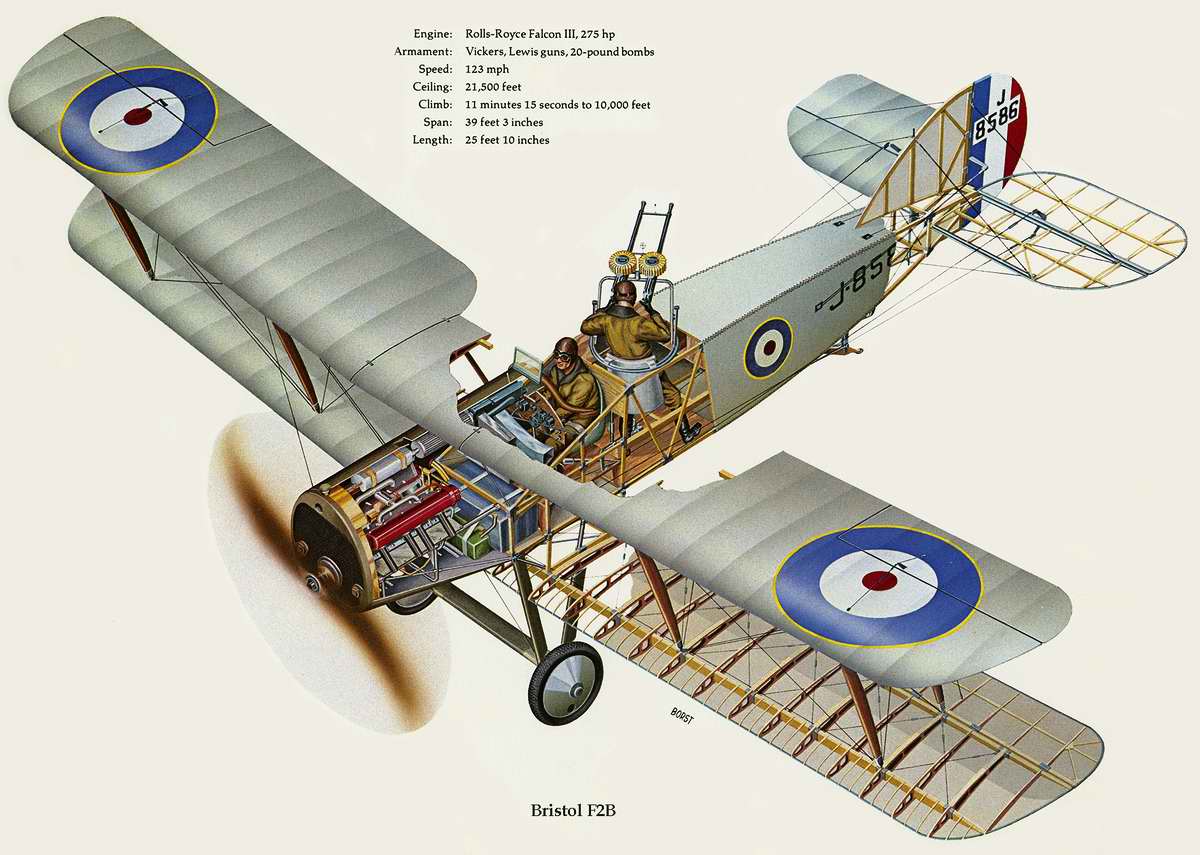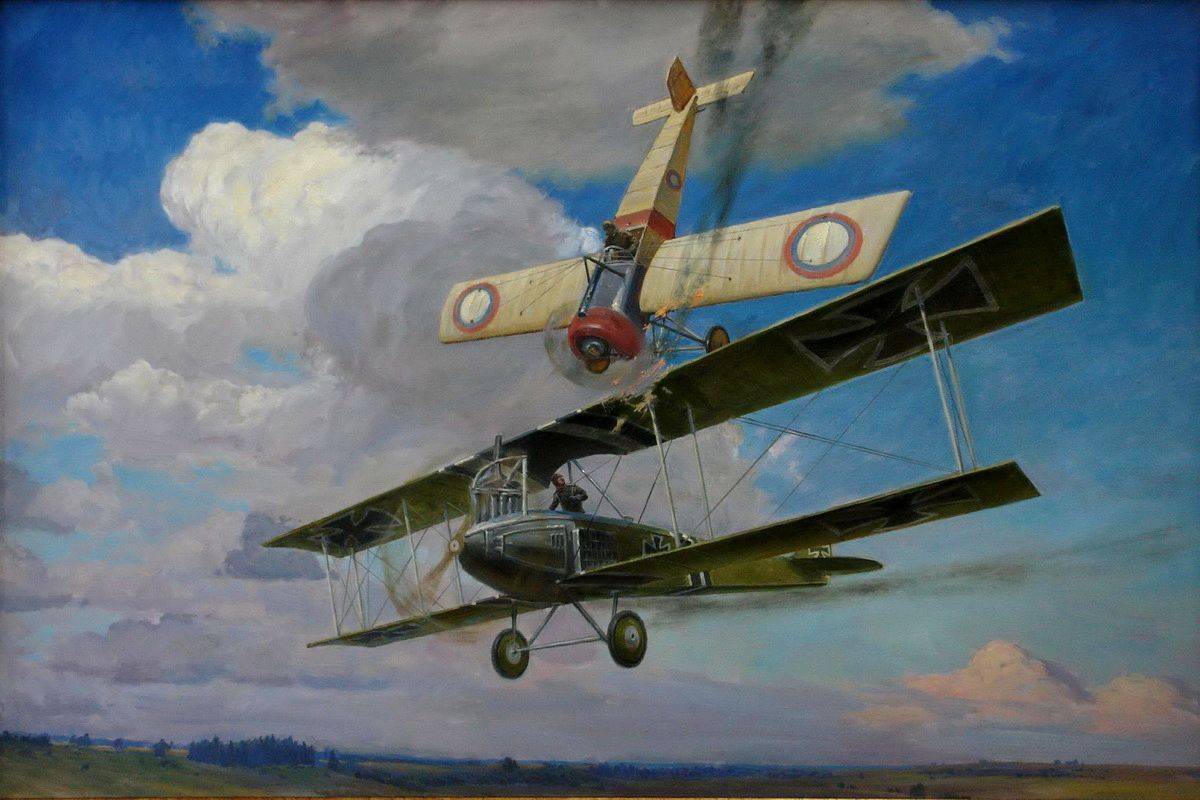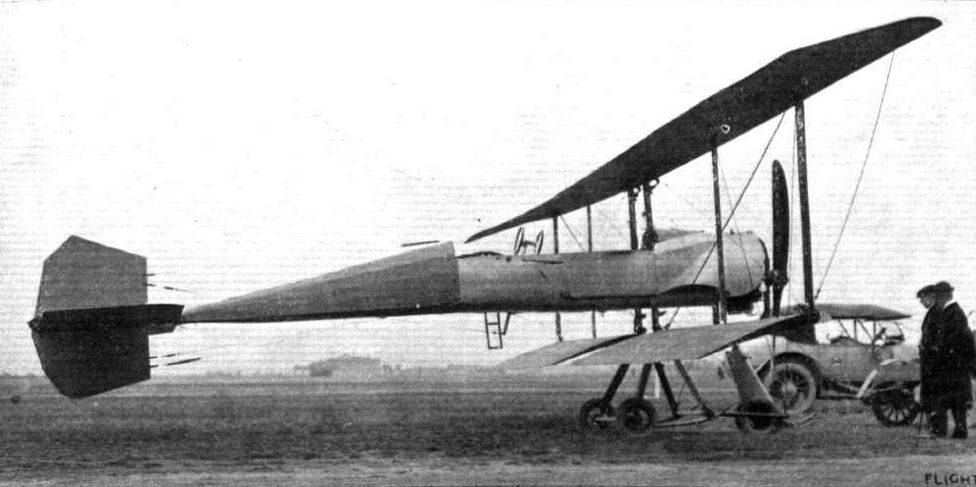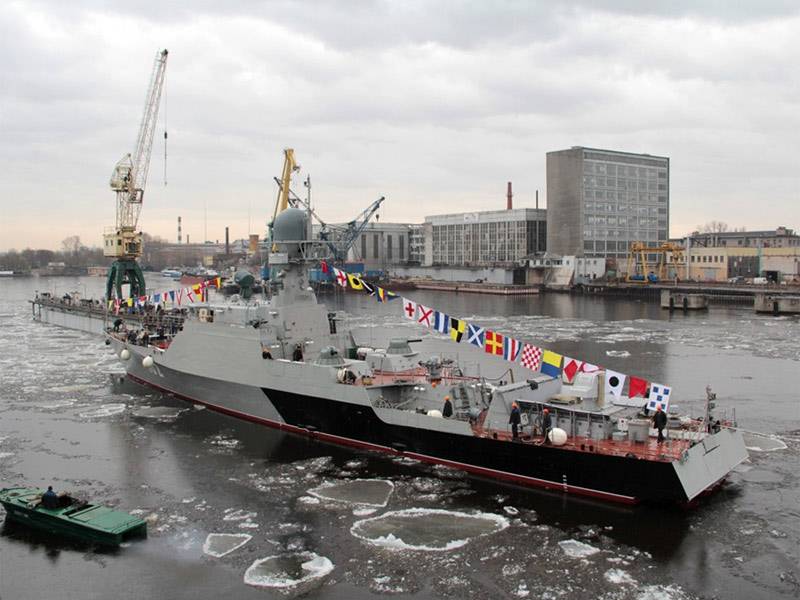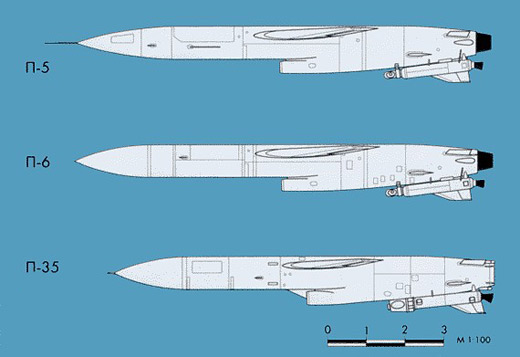Specifications (Br 19 A.2)
Data from The Encyclopedia of World Aircraft
General characteristics
- Crew: 2
- Length: 9.61 m (31 ft 6 in)
- Wingspan: 14.83 m (48 ft 8 in)
- Height: 3.69 m (12 ft 1 in)
- Wing area: 50 m2 (540 sq ft)
- Empty weight: 1,387 kg (3,058 lb)
- Max takeoff weight: 2,500 kg (5,512 lb)
- Fuel capacity: 365 l (96 US gal; 80 imp gal)
- Powerplant: 1 × Lorraine 12Ed Courlis W-12 liquid-cooled piston engine, 340 kW (450 hp)
Performance
- Maximum speed: 214 km/h (133 mph, 116 kn)
- Range: 800 km (500 mi, 430 nmi)
- Service ceiling: 7,200 m (23,600 ft)
Armament
- Guns: 1 × fixed, forward-firing 7.7 mm (0.30 in) Vickers machine gun, and two flexible, rearward-firing 7.7 mm (0.30 in) Lewis Guns.
- Bombs: Provision for light bombs.
Дизайн
Бреге 19 был sesquiplane , в котором нижнее крыле было существенно меньше , чем верхнее крыло, с обычной компоновкой и закрепленными крылами. Фюзеляж был эллипсоид в поперечном сечении и построен из рамы дюралевых труб. Breguet широко использовала дюралюминий в качестве строительного материала, что привело к необычайно легкой для своих размеров конструкции вместо стали или дерева. Он был быстрее, чем другие бомбардировщики и даже многие истребители, что вызвало всеобщий интерес, который был дополнительно увеличен успешными рекордными полетами. Носовая часть фюзеляжа была покрыта дюралюминиевыми листами, а хвостовая часть, хвостовая часть фюзеляжа и крылья – полотном . У него было обычное неубирающееся шасси с хвостовой опорой. Экипаж из двух человек, пилот и наблюдатель / бомбардир, сидел тандемом в открытых кабинах и имел двойное управление.
Были установлены самые разные типы двигателей, в основном рядные двигатели V-12 или W-12 с водяным охлаждением, включая следующие:
- Breguet-Bugatti U.16 : 370 кВт (500 л.с.) – используется на Br 19 и Br 23
- Farman 12We : 370 кВт (500 л.с.) – используется на Br 19-5
- Gnome & Rhône 9Ab Jupiter : 310 кВт (420 л.с.), используемый на Br 19 для Югославии
- Gnome & Rhône 9C Jupiter : 310 кВт (420 л.с.) – используется на Br 19-4
- Gnome & Rhône 14Kbrs : 520 кВт (700 л.с.) – используется на Br 19-8
- Hispano-Suiza 12Ha : 340 кВт (450 л.с.) – используется на Br 19
- Hispano-Suiza 12Hb : 370 кВт (500 л.с.) – используется на Br 19-6, Br 19 B2 и Br 19 CN2
- Hispano-Suiza 12Lb : 450 кВт (600 л.с.) – используется на Br 19ter
- Hispano-Suiza 12Nb : 480 кВт (650 л.с.) – используется на Br 19-7
- Hispano-Suiza 12Ybrs : 640 кВт (860 л.с.) – использовался на Br 19-9
- Renault 12Kb : 340 кВт (450 л.с.) – использовался на Br 19
- Renault 12Kd : 360 кВт (480 л.с.) – использовался на Br 19
- Liberty L-12 : 340 кВт (450 л.с.) – используется на Br 19bis
- Lorraine 12Da : 280 кВт (370 л.с.) – используется на Br 19
- Lorraine-Dietrich 12Db V12: 300 кВт (400 л.с.) – используется на Br 19
- Lorraine-Dietrich 12Eb : 340 кВт (450 л.с.) – используется на Br 19
- Lorraine-Dietrich 12Ed W12 с редуктором: – используется на Br 19
- Lorraine-Dietrich 12Hfrs : 540 кВт (720 л.с.) – используется на Br 19-10 и Br 230
- Salmson 18Cma : 370 кВт (500 л.с.) – используется на Br 19-3
Фиксированный 7,7-мм (0,303 дюйма) пулемет Виккерс с прерывателем управлялся пилотом, в то время как у наблюдателя были спаренные 7,7-мм (0,303 дюйма) орудия Льюиса на орудийном кольце. Также имелся четвертый пулемет, из которого наблюдатель мог стрелять вниз через отверстие в полу. Br.19CN2 вариант ночной истребитель был оснащен двумя фиксированными вперед стрельбы из пулеметов. Бомбардировщик мог нести до 472 кг (1041 фунт) бомб под фюзеляжем или небольшие бомбы до 50 кг (110 фунтов) по вертикали во внутреннем бомбовом отсеке . Разведывательный вариант мог нести 12 бомб по 10 кг (22 фунта). Разведывательный вариант имел установку камеры, которая была необязательной на варианте бомбардировщика. Все варианты оснащались магнитолой.
Record variants
Both standard and modified Breguet 19s were used for numerous record-breaking flights. The first was the Br.19 prototype, which won a military aircraft speed contest in Madrid on 17 February 1923. On 12 March 1923, it also set an international altitude record of 5,992 m (19,659 ft) carrying a 500 kg (1,100 lb) load. It was later bought by the Spanish government.
The Jesús del Gran Poder, a special version of the Breguet 19 that flew to Brazil from Spain in 1929
Many crews made long-distance flights in Br.19s. In February 1925, Thieffry flew from Brussels to Leopoldville in central Africa, a distance of 8,900 km (5,500 mi). Two Br.19 A2s were bought by the Japanese Asahi Shimbun newspaper and fitted with additional fuel tanks. They were flown by H. Abe and K. Kawachi on the Tokyo-Paris-London route in July 1925, covering 13,800 km (8,600 mi). Between 27 August and 25 September 1926, the Polish crew of Boleslaw Orlinski flew the Warsaw-Tokyo route (10,300 km (6,400 mi)) and back, in a modified Br.19 A2, despite the fact that one of its lower wings was broken on the way. On June 8, 1928 a modified Greek Br.A2 (“ΕΛΛΑΣ” en: Hellas), flown by C. Adamides and E. Papadakos, embarked on a long distance tour around the Mediterranean landing without incident at Tatoi airfield, Athens, on July 1. Between 1927 and 1930, Romanian, Yugoslavian and Polish Br.19s were often used in Little Entente air races.
Point D’Interrogation at Le Bourget
Breguet 19 GRs and TRs set several world records, mostly of long-distance non-stop flights, starting with Arrachart and Lemaitre’s 3,166 km (1,967 mi) flight from Paris to Villa Cisneros in 24½ hours on 2–3 February 1925. On 14–15 July 1926, Girier and Dordilly set a new record of 4,716 km (2,930 mi) between Paris and Omsk, beaten on 31 August-1 September by Challe and Weiser’s 5,174 km (3,215 mi), and on 28 October by Dieudonne Costes and Rignot’s 5,450 km (3,390 mi). From 10 October 1927 – 14 April 1928, Costes and Le Brix flew a Br.19 GR (named Nungesser-Coli) around the world, covering 57,000 km (35,000 mi) – though the journey between San Francisco and Tokyo was taken by ship.
The Super Bidon was created especially for the purpose of a transatlantic flight. It was named Point d’Interrogation (“The Question Mark”). Dieudonne Costes and Maurice Bellonte set a non-stop distance record of 7,905 km (4,912 mi) from Paris to Moullart on 27–29 September 1929 on this aircraft. Then on 1–2 September 1930, they flew from Paris to New York City, a distance of 6,200 km (3,900 mi) making the first non-stop east-west crossing of the North Atlantic by a fixed-wing aircraft. The second Super Bidon, the Spanish Cuatro Vientos, vanished over Mexico with M. Barberan and J. Collar Serra, after a transatlantic flight from Seville to Cuba on 10–11 June 1933.
Development
Breguet XIX prototype. Photo from L’Aerophile December,1921
The Breguet 19 was designed as a successor to a highly successful World War I light bomber, the 14. Initially, it was designed to be powered by a 340 kW (450 hp) Bugatti U-16 engine, driving a four-blade propeller, and such a prototype was shown on the 7th Paris Air Show in November 1921. A new design was flown in March 1922, featuring a conventional layout with a single 340 kW (450 hp) Renault 12Kb inline engine. The aircraft was built in a sesquiplane platform, with lower wings substantially smaller than the upper ones. After trials, the Breguet 19 was ordered by the French Army’s French Air Force in September 1923.
The first 11 Breguet 19 prototypes were powered by a number of different engines. A “trademark” of Breguet was the wide usage of duralumin as a construction material, instead of steel or wood. At that time, the aircraft was faster than other bombers, and even some fighter aircraft. Therefore, it met with a huge interest in the world, strengthened by its sporting successes. Mass production, for the Aéronautique Militaire and export, started in France in 1924.
Design
The Breguet 19 was a sesquiplane in which the lower wing was substantially smaller than the upper wing, with a conventional layout and braced wings. The fuselage was ellipsoid in cross-section and built up from a frame of duralumin pipes. Breguet made extensive use of duralumin as a construction material which resulted in an unusually light strusture for its size, instead of steel or wood. It was faster than other bombers, and even many fighter aircraft which resulted in widespread interest which was further increased by successful record flights. The forward fuselage was covered with duralumin sheets, while the tail, rear fuselage and wings were covered with linen. It had a conventional fixed landing gear with a tail skid. The crew of two, pilot and observer/bombardier, sat in tandem in open cockpits and were provided with dual controls.
A wide variety of engine types were fitted, mostly water-cooled V-12 or W-12 inline engines, including the following:
- Breguet-Bugatti U.16: 370 kW (500 hp) – used on Br 19 and Br 23
- Farman 12We: 370 kW (500 hp) – used on Br 19-5
- Gnome & Rhône 9Ab Jupiter: 310 kW (420 hp) used on Br 19 for Yugoslavia
- Gnome & Rhône 9C Jupiter: 310 kW (420 hp) – used on Br 19-4
- Gnome & Rhône 14Kbrs: 520 kW (700 hp) – used on Br 19-8
- Hispano-Suiza 12Ha: 340 kW (450 hp) – used on Br 19
- Hispano-Suiza 12Hb: 370 kW (500 hp) – used on Br 19-6, Br 19 B2 and Br 19 CN2
- Hispano-Suiza 12Lb: 450 kW (600 hp) – used on Br 19ter
- Hispano-Suiza 12Nb: 480 kW (650 hp) – used on Br 19-7
- Hispano-Suiza 12Ybrs: 640 kW (860 hp) – used on Br 19-9
- Renault 12Kb: 340 kW (450 hp) – used on Br 19
- Renault 12Kd: 360 kW (480 hp) – used on Br 19
- Liberty L-12: 340 kW (450 hp) – used on Br 19bis
- Lorraine 12Da: 280 kW (370 hp) – used on Br 19
- Lorraine-Dietrich 12Db V12: 300 kW (400 hp) – used on Br 19
- Lorraine-Dietrich 12Eb: 340 kW (450 hp) – used on Br 19
- Lorraine-Dietrich 12Ed W12 with reduction gear: – used on Br 19
- Lorraine-Dietrich 12Hfrs: 540 kW (720 hp) – used on Br 19-10 and Br 230
- Salmson 18Cma: 370 kW (500 hp) – used on Br 19-3
A fixed 7.7 mm (0.303 in) Vickers machine gun with an interrupter gear was operated by the pilot, while the observer had twin 7.7 mm (0.303 in) Lewis Guns on a gun ring. There was also a fourth machine gun, which could be fired by the observer downwards through an opening in the floor. The Br.19CN2 night fighter variant was fitted with two fixed forward-firing machine guns. The bomber could carry up to 472 kg (1,041 lb) of bombs under the fuselage, or small bombs up to 50 kg (110 lb) vertically in an internal bomb bay. The reconnaissance variant could carry 12 x 10 kg (22 lb) bombs. The reconnaissance variant had a camera mounting, which was optional on the bomber variant. All variants were equipped radio.
Operators
- The French Armys Aéronautique Militaire operated its first Breguet 19s in the A2 variant from the autumn of 1924, the B2 variant from June 1926, then the fighter C2 and CN2 variants. In the late 1920s and early 1930s, they were the most numerous French combat aircraft. In metropolitan France, they were withdrawn from service in the early 1930s; the last Br.19 CN2 was withdrawn in 1935. Until 1938, they were still used by the French Air Force (successor to the Aéronautique Militaire) in colonies in the Middle East and North Africa – among others, they were used there to suppress native rebellions.
- French Navy
- Greece
Hellenic Air Force acquired 30 Breguet 19 A2s and some were used against invading Italian forces in 1940, delivering valuable information on Italian movements.
- Italy
Regia Aeronautica bought one aircraft for tests.
Specifications (Br 19 A.2)
Data from The Encyclopedia of World Aircraft
General characteristics
- Crew: 2
- Length: 9.61 m (31 ft 6 in)
- Wingspan: 14.83 m (48 ft 8 in)
- Height: 3.69 m (12 ft 1 in)
- Wing area: 50 m2 (540 sq ft)
- Empty weight: 1,387 kg (3,058 lb)
- Max takeoff weight: 2,500 kg (5,512 lb)
- Fuel capacity: 365 l (96 US gal; 80 imp gal)
- Powerplant: 1 × Lorraine 12Ed Courlis W-12 liquid-cooled piston engine, 340 kW (450 hp)
Performance
- Maximum speed: 214 km/h (133 mph; 116 kn)
- Range: 800 km (497 mi; 432 nmi)
- Service ceiling: 7,200 m (23,622 ft)
Armament
- Guns: 1 × fixed, forward-firing 7.7 mm (0.30 in) Vickers machine gun, and two flexible, rearward-firing 7.7 mm (0.30 in) Lewis Guns.
- Bombs: Provision for light bombs.
Варианты записи
И стандартные, и модифицированные Breguet 19 были использованы в многочисленных рекордных полетах. Первым был прототип Br.19, который 17 февраля 1923 года выиграл соревнования по скорости военных самолетов в Мадриде. 12 марта 1923 года он также установил международный рекорд высоты в 5 992 м (19 659 футов) с 500-кг (1100 фунтов). нагрузка. Позже он был куплен правительством Испании.
Хесус дель Гран Poder , специальная версия Breguet 19 , который прилетел в Бразилию из Испании в 1929 году
Многие экипажи совершали дальние перелеты на Br.19. В феврале 1925 года Тифри вылетел из Брюсселя в Леопольдвиль в центральной Африке на расстояние 8 900 км (5 500 миль). Два Br.19 A2 были куплены японской газетой Asahi Shimbun и оснащены дополнительными топливными баками. На них летали Х. Абэ и К. Кавачи по маршруту Токио – Париж – Лондон в июле 1925 года, преодолев 13 800 км (8 600 миль). С 27 августа по 25 сентября 1926 года польский экипаж Болеслава Орлински совершил перелет по маршруту Варшава – Токио (10300 км (6400 миль)) и обратно на модифицированном Br.19 A2, несмотря на то, что одно из его нижних крыльев было сломано. в дороге. 8 июня 1928 г. модифицированный греческий Br.A2 (“ΕΛΛΑΣ” en: Hellas), пилотируемый К. Адамидесом и Э. Пападакосом, совершил дальний тур по Средиземному морю, без происшествий совершил посадку на аэродроме Татой в Афинах в июле. 1. Между 1927 и 1930 годами румынские, югославские и польские Br.19 часто использовались в воздушных гонках Малой Антанты .
Point D’Interrogation в Ле Бурже
Breguet 19 GR и TR установили несколько мировых рекордов, в основном по дальним беспосадочным перелетам, начиная с полета Аррахара и Леметра из Парижа до Виллы Сиснерос за 24,5 часа 2–3 февраля 1925 года, который пролетел 3 166 км (1 967 миль). 15 июля 1926 года Жирье и Дордилли установили новый рекорд – 4716 км (2930 миль) между Парижем и Омском , побитый 31 августа – 1 сентября Шаллом и Вайзером на 5 174 км (3215 миль), а 28 октября – Дьедон Кост и Риньо. 5450 км (3390 миль). С 10 октября 1927 года по 14 апреля 1928 года Костес и Ле Брикс совершили кругосветное путешествие на Br.19 GR (названном Nungesser – Coli ) на расстояние 57000 км (35000 миль), хотя путешествие между Сан-Франциско и Токио осуществлялось на корабле.
Супер Бидон был создан специально для трансатлантического перелета . Он получил название Point d’Interrogation («Знак вопроса»). 27–29 сентября 1929 года на этом самолете Дьедон Кост и Морис Беллонте установили на этом самолете рекорд беспосадочного расстояния 7 905 км (4912 миль) от Парижа до Мулларта . Затем 1–2 сентября 1930 года они вылетели из Парижа в Нью-Йорк на расстояние 6200 км (3900 миль), сделав первое беспосадочное пересечение Северной Атлантики с востока на запад на самолете с неподвижным крылом. Второй Super Bidon, испанский Cuatro Vientos , исчез над Мексикой вместе с М. Барбераном и Х. Коллар Серра после трансатлантического перелета из Севильи на Кубу 10–11 июня 1933 года.
Specifications (Br 19 A.2)
Data from The Encyclopedia of World Aircraft[]
General Characteristics
- Crew: 2
- Length: 9.61 m (31 ft 6 in)
- Wingspan: 14.83 m (48 ft 8 in)
- Height: 3.69 m (12 ft 1 in)
- Wing area: 50 m2 (540 sq ft)
- Empty weight: 1,387 kg (3,058 lb)
- Max takeoff weight: 2,500 kg (5,512 lb)
- Fuel capacity: 365 l (96 US gal; 80 imp gal)
- Powerplant: 1 × Lorraine 12Ed Courlis W-12 liquid-cooled piston engine, 340 kW (450 hp)
Performance
- Maximum speed: 214 km/h (133 mph, 116 kn)
- Range: 800 km (500 mi, 430 nmi)
- Service ceiling: 7,200 m (23,600 ft)
Armament
- Guns: 1 × fixed, forward-firing 7.7 mm (0.30 in) Vickers machine gun, and two flexible, rearward-firing 7.7 mm (0.30 in) Lewis Guns.
- Bombs: Provision for light bombs.
Bibliography
- Andersson. Lennart. Histoire de l’aéronautique persane, 1921–1941: La première aviation du Chah d’Iran . Avions: Toute l’aéronautique et son histoire . July 1998 . 76 . 2–12 . History of the Persian Air Force, 1921–1941: The First Aircraft of the Shah of Iran . French . 1243-8650.
- Book: Andersson, Lennart . A History of Chinese Aviation: Encyclopedia of Aircraft and Aviation in China to 1949. 2008 . Taipei, Republic of China . AHS of ROC . 978-9572853337.
- Book: Carr. John. On spartan wings : the Royal Hellenic Air Force in World War Two. 2012. Pen & Sword Military. Barnsley. 17. 978-1848847989.
- Claveau. Charles. Les Avions Louis Breguet 1919–1945. Le Trait d’Union. March–April 1997. 172. fr.
- Green . William . William Green (author). Gordon . Swanborough . Pierre . Leyvastre . The Saga of the Ubiquitous Breguet . . Seven . July–September 1978 . 161–181.
- Daniel P.. Hagedorn. Talkback. Air Enthusiast . September–October 1996. 65. 80 . 0143-5450.
- Kotelnikov. V.. Kulikov. V.. Cony. C.. amp . Les avions français en URSS, 1921–1941 . Avions: Toute l’Aéronautique et son histoire . November 2001 . 104 . 37–43 . French Aircraft in the USSR, 1921–1941 . fr . 1243-8650.
- Wauthy. Jean-Luc. de Neve. Florian. amp. Les aéronefs de la Force Aérienne Belge, deuxième partie 1919–1935. Le Fana de l’Aviation . June 1995 . 305 . 28–33 . 0757-4169. fr. Aircraft of the Belgian Air Force.
Рекомендации
Цитаты
- ^
- Air International Ноябрь 1981, с. 218, 252.
- Элверт, Ширманн и Ланг 2008, стр. 182.
- Air International Ноябрь 1981 г., стр. 252–253.
- Air International Ноябрь 1981 г., стр. 216–218.
- Ламберт 1993, стр. 81–82.
- Вагнер 2009, стр. 122.
- ^ Джексон 1992, стр 58, 71.
- Bowman 2007, стр. 14–17.
- Полет 16 октября 1969 г., стр. 600.
- Джексон 1992, стр. 58.
- Уоллес 1984, стр. 27.
- Джексон 1992, стр. 77.
- ^ «Автомобилиа». Toutes les voitures françaises 1948 (салон в Париже, октябрь 1947 г.). Париж: История и коллекции. № 26: Страница 18. 1998.
Библиография
- Боуман, Мартин В. SEPECAT Jaguar. Лондон: Книги о ручке и мече, 2007. ISBN 1-84415-545-5.
- Эльверт, Юрген. Сильвен Ширманн, Питер Ланг. Времена перемен: Германия в Европе 20-го века, Питер Лэнг, 2008. ISBN 90-5201-483-3.
- Джексон, Пол. «СЕПЕКАТ Ягуар». Журнал World Air Power. Том 11, зима 1992 г., стр. 52–111. Лондон: Aerospace Publishing, 1992. ISBN 1-874023-96-4. ISSN 0959-7050.
- Ламберт, Марк. (редактор). Самолеты всего мира Джейн 1993–94. Колсдон, Великобритания: Jane’s Data Division, 1993. ISBN 0-7106-1066-1.
- «Атлантика нового поколения». Air International, Ноябрь 1981, т. 21 № 5. С. 213–218, 252–253.
- Уоллес, Уильям. Двусторонние связи Великобритании в Западной Европе. Лондон: Рутледж и Кеган Пол, 1984. ISBN 0-7102-0298-9.
Operational history
The Breguet had its baptism of fire during the Greco-Italian War, in World War II. At the outbreak of war, 18 Breguet were on line with 1 Observation (or Army Cooperation) Mira, under I Corp Command, based at Perigiali, near Corinth and with 2 Observation Mira under II Corps command, based at Larissa and Kozani. On 4 November 1940, a RHAF (Royal Hellenic Air Force) Breguet from 2 Mira was sent looking for the attacking 3rd Julia Alpine Division, locating it in a mountain pass near Metsovo. Three more Breguets sent to bomb the Italian division were in turn attacked by three Fiat CR.42 fighters. A Breguet was shot down, one crash-landed and the third returned to base, though badly shot up.
Military use
The first female pilot in Turkey, Sabiha Gökçen , took part in the bombing of Dersim . Here she stands in front of a Breguet 19 in the bomber version.
From autumn 1924 the French Air Force used the A2 variant. The B2 was introduced in June 1926, then the C2 and the CN2. It was the most widely used aircraft in the French Air Force until the early 1930s. Its use ended in the French colonies around 1938.
The Polish Air Force bought 250 Breguet 19 A2 and B2 with Lorraine-Dietrich 12Eb (450 HP) engines between 1925 and 1930. At the end of the 1930s, they were used as training aircraft. In the Second World War , however, the Poles no longer used the machines.
Belgium bought 6 Br.19 B2 in 1924 with license rights. 146 Br.19 A2 and B2 were reproduced at SABCA 1926–1930.
Spain bought a prototype and license rights in 1923. 19 aircraft were bought completely, then 26 were assembled from French parts. Then another 177 units were built at CASA. In the Spanish Civil War , a total of 135 Spanish Breguet fought 19 on the Republican side and 20 Polish machines. However, the machines suffered heavy losses.
Yugoslavia bought 100 Br.19 A2 in 1924 and a building license in 1927. 300 machines were manufactured in the Kraljevo plant. Many machines were used in World War II. After the occupation of Yugoslavia, the Croatian air force received 46 aircraft from the Germans. The partisans of Tito used several captured machines.
The Romanian Air Force bought 163 Breguet 19 types. The Greek Air Force owned 30 machines that were used in the Italian attack in 1940. Iran, then called Persia, bought two machines in 1925.
Other machines went to the Republic of China , 70 to Turkey , 25 to Argentina , five to Brazil , twelve to Venezuela , Uruguay and Bolivia , which used its ten machines in the Chaco War against Paraguay .
Design
The Breguet 19 was a sesquiplane in which the lower wing was substantially smaller than the upper wing, with a conventional layout and braced wings. The fuselage was ellipsoid in cross-section and built up from a frame of duralumin pipes. Breguet made extensive use of duralumin as a construction material which resulted in an unusually light strusture for its size, instead of steel or wood. It was faster than other bombers, and even many fighter aircraft which resulted in widespread interest which was further increased by successful record flights. The forward fuselage was covered with duralumin sheets, while the tail, rear fuselage and wings were covered with linen. It had a conventional fixed landing gear with a tail skid. The crew of two, pilot and observer/bombardier, sat in tandem in open cockpits and were provided with dual controls.
A wide variety of engine types were fitted, mostly water-cooled V-12 or W-12 inline engines, including the following:
Breguet-Bugatti U.16
– used on Br 19 and Br 23
Farman 12We
– used on Br 19-5
Gnome & Rhône 9Ab Jupiter
used on Br 19 for Yugoslavia
Gnome & Rhône 9C Jupiter
– used on Br 19-4
Gnome & Rhône 14Kbrs
– used on Br 19-8
Hispano-Suiza 12Ha
– used on Br 19
Hispano-Suiza 12Hb
– used on Br 19-6, Br 19 B2 and Br 19 CN2
Hispano-Suiza 12Lb
– used on Br 19ter
Hispano-Suiza 12Nb
– used on Br 19-7
Hispano-Suiza 12Ybrs
– used on Br 19-9
Renault 12Kb
– used on Br 19
Renault 12Kd
– used on Br 19
Liberty L-12
– used on Br 19bis
Lorraine 12Da
– used on Br 19
- Lorraine-Dietrich 12Db V12: – used on Br 19
- Lorraine-Dietrich 12Eb
– used on Br 19
- Lorraine-Dietrich 12Ed W12 with reduction gear: – used on Br 19
- Lorraine-Dietrich 12Hfrs
– used on Br 19-10 and Br 230
Salmson 18Cma
– used on Br 19-3
A fixed Vickers machine gun with an interrupter gear was operated by the pilot, while the observer had twin Lewis Guns on a gun ring. There was also a fourth machine gun, which could be fired by the observer downwards through an opening in the floor. The Br.19CN2 night fighter variant was fitted with two fixed forward-firing machine guns. The bomber could carry up to of bombs under the fuselage, or small bombs up to vertically in an internal bomb bay. The reconnaissance variant could carry 12 x bombs. The reconnaissance variant had a camera mounting, which was optional on the bomber variant. All variants were equipped radio.
Development
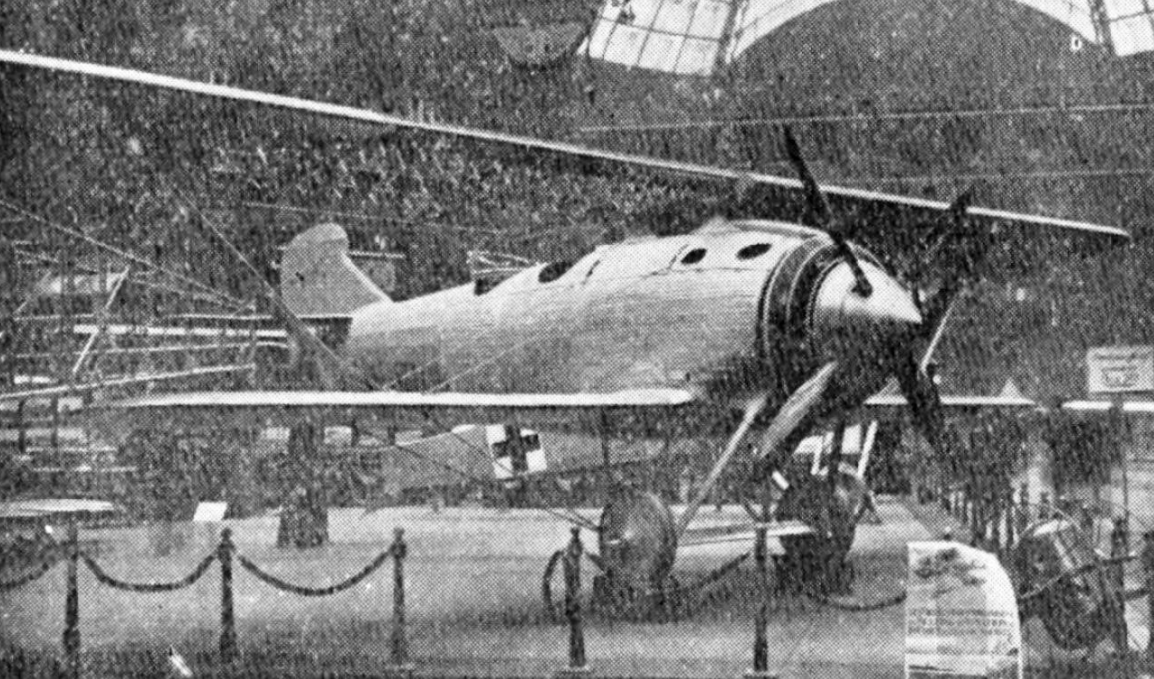
Breguet XIX prototype. Photo from L’Aerophile December,1921. https://handwiki.org/wiki/index.php?curid=1183520
The Breguet 19 was designed as a successor to a highly successful World War I light bomber, the 14. Initially, it was designed to be powered by a 340 kW (450 hp) Bugatti U-16 engine, driving a four-blade propeller, and such a prototype was shown on the 7th Paris Air Show in November 1921.[] A new design was flown in March 1922, featuring a conventional layout with a single 340 kW (450 hp) Renault 12Kb inline engine. The aircraft was built in a sesquiplane platform, with lower wings substantially smaller than the upper ones. After trials, the Breguet 19 was ordered by the French Army’s French Air Force in September 1923.
The first 11 Breguet 19 prototypes were powered by a number of different engines. A “trademark” of Breguet was the wide usage of duralumin as a construction material, instead of steel or wood. At that time, the aircraft was faster than other bombers, and even some fighter aircraft. Therefore, it met with a huge interest in the world, strengthened by its sporting successes. Mass production, for the Aéronautique Militaire and export, started in France in 1924.

